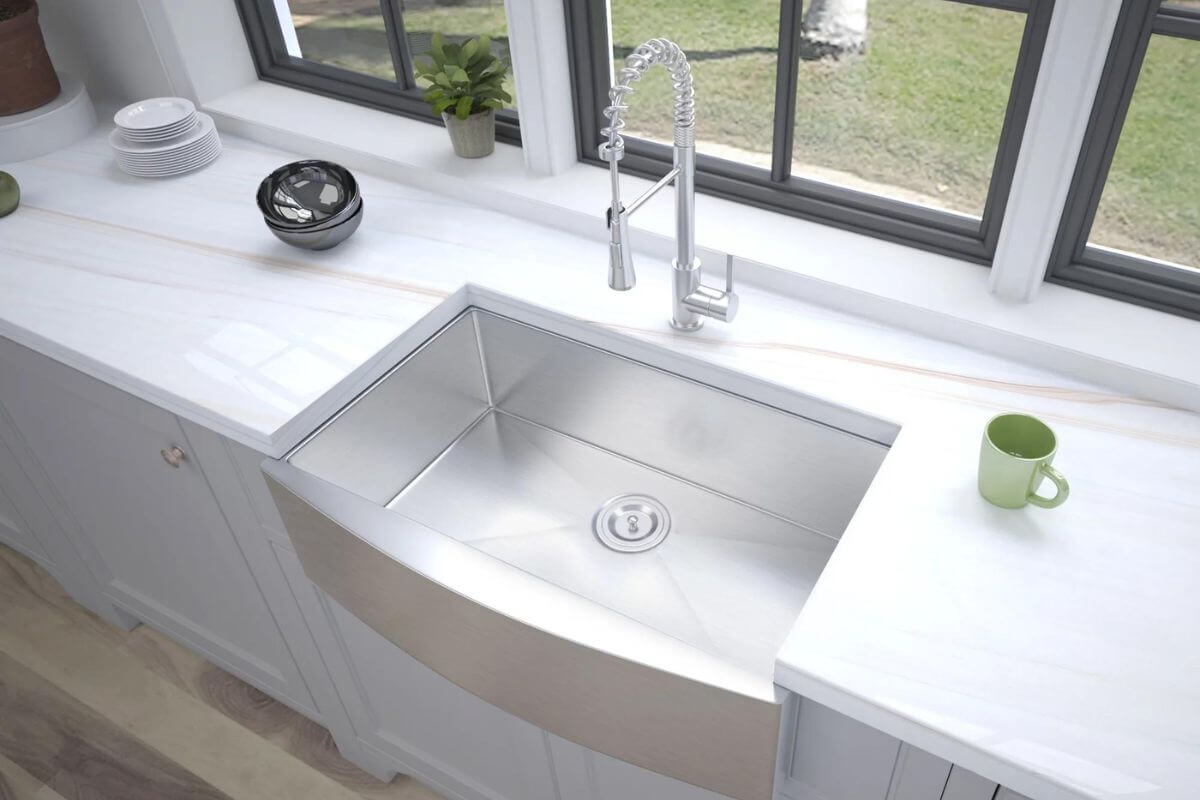Fireclay Sinks: Classic Elegance Meets Durability
The Composition of Fireclay Sinks
Fireclay sinks are crafted from a blend of clay and glaze, which is then heated at high temperatures to create a dense and solid surface. This traditional crafting technique gives fireclay sinks their unique charm and durability.
Aesthetics and Style
Fireclay sinks are renowned for their timeless appeal. They often feature a glossy finish that adds a touch of elegance to any kitchen. The available designs range from farmhouse apron-front styles to sleek, modern options, allowing homeowners to find a sink that perfectly complements their kitchen design.
Durability and Resistance
Fireclay sinks are incredibly durable and can withstand heavy use. They are resistant to chips, scratches, and fading, making them a practical choice for busy kitchens. However, they are more prone to cracking if heavy objects are dropped into them.
Maintenance and Care
Maintaining a fireclay sink is relatively easy. Regular cleaning with a mild detergent and soft cloth is usually sufficient to keep it looking pristine. Avoiding abrasive cleaners and heavy impacts will help prolong the sink’s lifespan.

Stainless Steel Sinks: Contemporary Shine with Practicality
The Composition of Stainless Steel Sinks
Stainless steel sinks are made from a mixture of metals, primarily iron and chromium. This composition gives stainless steel its distinctive shine and corrosion-resistant properties.
Modern Aesthetics and Versatility
Stainless steel sinks are favored for their sleek and contemporary look. They seamlessly integrate into various kitchen styles, from traditional to modern, due to their minimalist design.
Durability and Resilience
Stainless steel sinks are highly durable and can endure tough conditions. They are resistant to corrosion, rust, and stains, making them ideal for kitchens with heavy water usage. However, they can be prone to scratching over time.
Maintenance and Cleaning
Caring for a stainless steel sink involves regular cleaning with soap and water, followed by drying to prevent water spots. To minimize scratching, using a soft sponge or cloth is recommended. Stainless steel sinks can also benefit from occasional polishing to maintain their shine.
Comparing Fireclay and Stainless Steel Sinks
Heat Resistance
Both fireclay and stainless steel sinks exhibit good heat resistance. However, fireclay sinks can withstand higher temperatures, making them suitable for handling hot cookware without the risk of damage.
Stain and Scratch Resistance
Fireclay sinks excel in stain resistance, while stainless steel sinks can be vulnerable to stains if not properly maintained. In terms of scratch resistance, fireclay sinks are less likely to scratch, but they are more prone to chipping compared to stainless steel.
Noise and Vibration Control
Stainless steel sinks tend to be noisier when water hits the surface, but modern advancements include sound-absorbing materials to minimize this issue. Fireclay sinks, on the other hand, are quieter and provide a more serene environment.
Cost and Budget Considerations
Stainless steel sinks are generally more budget-friendly compared to fireclay sinks. Fireclay sinks often come with a higher price tag due to their crafting process and elegant appearance.
Choosing the Right Sink for You
Kitchen Style and Overall Design
If you’re aiming for a rustic, classic, or farmhouse-style kitchen, a fireclay sink could be the perfect fit. For contemporary and modern kitchens, stainless steel sinks offer a sleek and seamless look.
Usage and Daily Routine
Consider how you use your kitchen on a daily basis. If you frequently handle hot pots and pans, a fireclay sink’s heat resistance might be more suitable. If durability against stains and scratches is a priority, stainless steel could be the better choice.
Longevity and Investment
Both fireclay and stainless steel sinks have long lifespans, but fireclay sinks may require more delicate handling to prevent chipping. Stainless steel sinks offer a lower upfront cost, making them a practical investment for budget-conscious homeowners.
Installation and Maintenance
Professional Installation
To ensure optimal functionality and longevity, it’s advisable to have either sink type professionally installed. An experienced installer can help prevent any issues related to fitting and sealing.
Cleaning and Care Tips
Regular maintenance is key to prolonging the life of your chosen sink. For fireclay sinks, avoid heavy impacts and abrasive cleaners. For stainless steel sinks, gentle cleaning and occasional polishing will maintain their appearance.
Conclusion
In the ongoing debate of fireclay vs stainless steel sinks, there’s no one-size-fits-all answer. Your decision should be based on your kitchen’s style, your daily routine, and your budget. Both materials have their unique advantages and considerations, ensuring that you’ll find the perfect sink to elevate your kitchen experience.
FAQs
Can I place hot pots directly into a fireclay sink?
Yes, fireclay sinks are heat-resistant and can handle hot cookware.
Do stainless steel sinks scratch easily?
Stainless steel sinks can develop scratches over time, but they can be minimized with proper care.
Which sink is more budget-friendly?
Stainless steel sinks are generally more affordable than fireclay sinks.
Are fireclay sinks prone to chipping?
While fireclay sinks are durable, they can chip if heavy objects are dropped into them.
Do stainless steel sinks discolor or stain?
With regular cleaning and maintenance, stainless steel sinks can resist discoloration and stains, but neglecting care might lead to issues.



